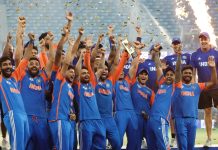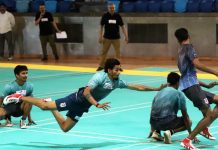
The team owners decided their home bases; these state associations were paid a specific sum to use their stadia. This was the reasoning that Srinivasan used to convince the Tamil Nadu Cricket Association to host the matches for CSK, which was purchased by the Srinivasan promoted India Cements. The BCCI promised attractive annual payments from IPL profits to the associations which didn’t have a home team; the latter could use the money to improve the state of cricket in their respective states.
That left the broadcaster, who bid for the telecast rights in the subcontinent and rest of the world. Although it paid a market price, the BCCI added an altruistic clause. The telecast rights agreement stated that the broadcaster would pay the annual amount only if the IPL matches had a certain minimum TRPs (Television Rating Points), which assured a minimum TV viewership. Once the ipl proved successful after the first season, the contract was renegotiated and this clause was removed.
Game theory rationality
Modi’s IPL model was plonked on four economic pillars. These included a tweak in capitalism to avoid the Marxian conflict between the various classes, theory of rational behaviour, game theory and the role of ‘Regulator Modi’ to ensure perfect competition between the stakeholders. Let’s consider the first and last ones first. Since it was a winwin for everyone involved, there was a minimal chance for conflicts between the team owners, players, bcci, broadcaster and state associations. Viewers would be glued to their TV sets if they were given an exciting mix of cricket and entertainment.
In case there was a problem, Modi with his over-encompassing powers as the ipl commissioner could step in instantly to sort out the wrinkles. There was no way anyone would transgress their respective lines; it was a case of perfect ‘balance of power’, which was monitored by the strongman Modi. In the first three seasons, the former ipl head used his powers to sort out issues between the team owners and broadcaster, whose contract was renegotiated before the second season in 2009.
The theory of rational behaviour states that each individual or firm is rational enough to choose an option that delivers the best results. The sum of these choices results in a social behaviour that may benefit all the stakeholders. Modi felt that this would be the case with IPL since the benefactors knew in advance that the game was a win-win one for them.
According to Avinash Dixit and Barry Nalebuff, game theory attempts to determine “mathematically and logically the actions that ‘players’ should take to secure the best outcomes for themselves in a wide array of ‘games’.” However, the outcome for each participant “depends on the choices of all”. The end result can range from zero-sum game, where the “interests of the players conflict totally, so that one person’s gain always is another’s loss”, to positive-sum game, where there is a mutual gain for both. There can also be a negative-sum game with both mutual harm and conflict.
In this case too, Modi felt that game theory, as applied to IPL and its stakeholders, would lead to a positive-sum result. The reason: they knew that they could earn huge profits, although in varying degree, if they played the game in the ‘right’ spirit, as defined by the former IPL commissioner. There was no incentive to break the rules or go out of line.
Irrationality of the herd
So far so good! Adam Smith, the father of capitalism, and his followers maintained that greed was good, and an invisible hand of the market would ensure perfect competition as long as an unbiased regulator was in place. ipl had all these ingredients, and more since it married the best of capitalism with the best of socialism. But as experiences have proved, there is no end to greed and it is natural for the powerful stakeholders to transcend towards monopolistic and even corruptible tendencies.
Modern economic theories also maintain that there is an inherent irrationality in the behaviour of individuals and firms. As Amos Teversky and Daniel Kahneman proved, such irrationality can stem from several factors such as reference dependence (when people have reference points to define gain and loss), loss aversion, and diminishing sensitivity to gain and loss. What is worse is that such irrationality get compounded and multiplied due to a herd mentality. The best way to gauge this attitude is in the stock markets when people blindly sell or buy stocks only because others did it.
Ever since the beginning of IPL , hints about excessive greed, irrational behaviour to monopolise and dominate, and herd mentality were visible. Modi broke his own ‘perfect’ rules several times. He allowed several conflicts of interests to reside within the deep chasms of IPL. These included Srinivasan’s ownership of CSK, which doomed the former BCCI president. Modi’s family members and friends owned three other IPL franchisees, including Rajasthan Royals, Kings XI Punjab and Kolkata Knight Riders. In the first three seasons, rules were tweaked to favour a few franchisees. After his ouster Modi claimed that he kept IPL clean and blamed Srinivasan for various lapses.
In early 2010, Modi emerged as the epicentre of one of the biggest storms that rocked the league. When BCCI decided to add two new franchisees, Modi allegedly favoured two bidders, even though his rational brain asked him not to do so. This angered the competitors, and they forced the BCCI to agree to a rebid. Stung by the reversal of events, Modi tried to hit back at one of the subsequent winners. This led to his sack in May 2010. Later as the blame game began, Modi and Srinivasan hurled several charges of corruption, impropriety and manipulation against each other.
Their actions deepened the initial cracks within the original business model. The plague of excessive greed gripped some of the players, umpires and others. IPL quickly emerged as the fastest way to earn illegal profits through match fixing and illegal betting. Bookies and punters wooed players, team owners, officials and umpires, and wielded control over this ‘herd’. This led to the match fixing scandals in 2012 and 2013. The latter proved formidable when Raj Kundra of Rajasthan Royals and Gurunath Meiyappan, who was the son-in-law of Srinivasan and closely connected with CSK, were found guilty of illegal betting. Both were suspended for life and their teams for two years.
After the popularity of IPL in specific, and T20 cricket in general, the purists lamented that this was the beginning of the end of a beautiful gentlemanly game. One can say it for a fact that the game has changed in both positive and negative ways. A test cricketer from the 1950s, or even the 1970s, will be baffled by what he will see on the field these days.
However, the idea of the IPL was doomed. In the hype, hope and hoopla about his business model, Modi and BCCI couldn’t see the inherent conflicts of interests that they created deliberately. These had to give in at some point in time and bring the league crashing down. They counted too much on the rational behaviour of the IPL crowd, which would ensure that no one complained about each other or acted against each other. They failed to recognise the power of excessive greed, impact of irrational behaviour and the natural tendency to swerve towards ill-gotten gains.













